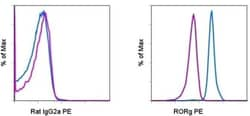Learn More
Invitrogen™ ROR gamma (t) Monoclonal Antibody (AFKJS-9), PE, eBioscience™, Invitrogen™
Rat Monoclonal Antibody
3110.00 SEK - 4575.00 SEK
Specifications
| Antigen | ROR gamma (t) |
|---|---|
| Clone | AFKJS-9 |
| Concentration | 0.2 mg/mL |
| Applications | Flow Cytometry |
| Classification | Monoclonal |
| Product Code | Brand | Quantity | Price | Quantity & Availability | |||||
|---|---|---|---|---|---|---|---|---|---|
| Product Code | Brand | Quantity | Price | Quantity & Availability | |||||
|
15219269
|
Invitrogen™
12-6988-80 |
25 μg |
3110.00 SEK
25µg |
Please sign in to purchase this item. Need a web account? Register with us today! | |||||
|
15229269
|
Invitrogen™
12-6988-82 |
100 μg |
4575.00 SEK
100µg |
Please sign in to purchase this item. Need a web account? Register with us today! | |||||
Description
Description: The AFKJS-9 monoclonal antibody reacts with the mouse, human and rhesus monkey ROR gamma (t) protein. ROR gamma is a member of the retinoic acid-related orphan receptor (ROR) family, which also includes ROR alpha and ROR beta. ROR family proteins are ligand-dependent transcription factors that play roles in multiple physiological processes. ROR gamma is expressed in several tissues including liver, lung, muscle, heart and kidney. Furthermore, it was discovered that alternative transcription results in the expression of an isoform, ROR gamma (t), which is expressed exclusively in cells of the lymphoid compartment, namely CD4+CD8+ double-positive thymocytes, Th17 cells of the periphery and lymphoid tissue inducer (LTi) cells of lymphoid organs. The ROR gamma (t) isoform differs from ROR gamma by three unique amino acids at its amino terminus. Therefore, the AFKJS-9 antibody will react with both the ROR gamma and ROR gamma (t) isoforms. Applications Reported: This AFKJS-9 antibody has been reported for use in intracellular staining followed by flow cytometric analysis. Applications Tested: This AFKJS-9 antibody has been tested by intracellular staining followed by flow cytometric analysis of mouse thymocytes and Th17-polarized splenocytes using the Foxp3/Transcription Factor Staining Buffer Set (cat. 00-5523-00) and protocol.
ROR gamma, a NR1 Thyroid Hormone-Like receptor, has been shown to affect thymopoiesis, bone metabolism, T-cell apoptosis, and lymphoid organogenesis. ROR gamma has been shown to promote thymocyte survival by activating the expression of the antiapoptotic protein Bcl-x(L). ROR gamma is also required for the development of lymph nodes and Peyer's patches. It has been shown that ROR gamma(t), a thymus-specific isoform of ROR gamma from mouse, inhibits Fas ligand expression and cytokine secretion in immature thymocytes. ROR gamma binds as a monomer to response elements composed of a single core motif, GGTCA, preceded by a 6 bp AT-rich sequence. ROR gamma expression has been documented in mouse thymus, adipose, bone, skeletal muscle, liver, and kidney, and in human skeletal muscle. ESTs have been isolated from human tissue libraries, including cancerous head/neck, germ cell, and prostate, and normal colon, head/neck, lung, liver/spleen, and pancreas. ROR gammat t (RORgt) is an isoform of RORC.Specifications
| ROR gamma (t) | |
| 0.2 mg/mL | |
| Monoclonal | |
| Liquid | |
| RUO | |
| PBS with 0.09% sodium azide; pH 7.2 | |
| EGK_01272; IMD42; MGC129539; NR1F3; nuclear receptor ROR-gamma; Nuclear receptor RZR-gamma; nuclear receptor subfamily 1 group F member 3; RAR related orphan receptor C; RAR-related orphan nuclear receptor variant 2; RAR-related orphan receptor C; RAR-related orphan receptor C, isoform a; RAR-related orphan receptor gamma; retinoic acid-binding receptor gamma; retinoid-related orphan receptor gamma; retinoid-related orphan receptor-gamma; ROR Gamma; ROR gamma t; Rorc; Rorg; RORgamma; RORgt; RP11-98D18.11-001; RZRG; RZR-GAMMA; Thor; Thymus orphan receptor; TOR | |
| Rorc | |
| Primary | |
| 4°C, store in dark, DO NOT FREEZE! | |
| Rorc |
| AFKJS-9 | |
| Flow Cytometry | |
| PE | |
| Rat | |
| Human, Mouse, Rhesus Macaque | |
| P51449, P51450 | |
| 19885, 6097, 717052 | |
| IgG2a κ | |
| Affinity Chromatography | |
| Antibody |
For Research Use Only.
Your input is important to us. Please complete this form to provide feedback related to the content on this product.






